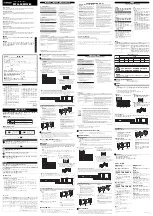
43
Signet 8900 Multi-Parameter
TDS Factor
Some industries need to display a conductivity value as Total
Dissolved Solids (TDS), measured in units of parts per million
(PPM) or parts per billion (PPB).
•
1 PPM is equivalent to 1 mg per liter.
•
1 PPB is equivalent to 1
μ
g per liter.
•
The 8900 calculates PPM or PPB by dividing the
μ
S value by
a TDS Factor that you defi ne.
•
TDS factors can vary widely, ranging from 1.50 to 2.50
μ
S
per PPM. Methods for establishing a TDS factor are beyond
the scope of this manual.
•
The 8900 will accept TDS factor values from 0.01 to 99999.9
μ
S per PPM.
(factory preset = 2.00
μ
S per PPM)
NOTE: The 8900 TDS factor must be set in PPM.
TDS Factor = Conductivity (
μ
S) ÷Total dissolved solids (PPM)
PPM = Solution conductivity (
μ
S) ÷ TDS Factor
Example:
•
Solution conductivity = 150
μ
S
•
TDS = 80 PPM
•
TDS Factor = 150
μ
S ÷ 80 PPM =
1.88
μ
S per PPM
Temperature Effects
Conductivity measurement is highly dependent on temperature.
The basic rule is that higher temperatures result in greater
conductance (less resistance).
Temperature effects are expressed as the percentage of
conductivity change (in
μ
S) per °C. The conductivity value is
generally referenced to 25 ºC. The 8900 has three temperature
compensation options:
None
USP standards for pharmaceutical waters require that the
measurement be made without temperature compensation.
USP limits are discussed in Appendix D.
Pure Water (Standard Compensation)
This selection is used for measurements of very clean water,
less than 0.2
μ
S. Temperature effects are not linear in this
range, so the temperature coeffi cient is not easily determined.
This selection is recommended for all Resistivity applications
measuring from 5 M
Ω
to 18 M
Ω
. This selection conforms to
ASTM standard D1125 and D5391.
Lin
e
ar
This selection allows you to calculate a custom temperature
compensation value for Conductivity measurements in the range
of 0.2
μ
S and greater (Resistivity applications measuring less
than 5 M
Ω
). The procedure is outlined in the section on the right.
Calculating a Linear Temperature Coeffi cient
1.
Set TC Mode to NONE (see SETUP menu).
2.
Heat a sample solution close to the maximum process
temperature. Place sensor in the sample solution and
allow several minutes for stabilization. Record the 8900
temperature and conductivity values in the spaces provided:
Displayed temperature:
T1 = _______ °C
Displayed conductivity:
C1 = _______
μ
S
3.
Cool the sample solution close to the minimum process
temperature. Place sensor in the sample solution allowing
several minutes for stabilization. Record displayed
temperature and conductivity values in the spaces provided:
Displayed temperature:
T2 = _______ °C
Displayed conductivity:
C2 = _______
μ
S
(A 10% change in conductivity between steps 2 and 3 is
recommended.)
4.
Substitute recorded readings (steps 2 and 3) into the following
formula:
TC Slope = 100 x (C1 - C2)
(C2 x (T1 - 25)) - (C1 x (T2 - 25))
Example: A sample solution has a conductivity of 205
μ
S @
48 °C. After cooling the solution, the conductivity was measured
at 150
μ
S @ 23 °C. (C1 = 205, T1 = 48, C2 = 150, T2 = 23)
The TC is calculated as follows:
TC Slope = 100 x (205 - 150) = 5500 = 1.42%/°C
(150 x (48 - 25)) - (205 x (23 - 25)) 3860
Conductivity Calibration Procedure
Wet Calibration with NIST Traceable Solutions:
•
When using NIST traceable standards, review the
temperature information provided with the test solution.
•
Prevent contamination of the test solution.
•
The sensor must be at the temperature specifi ed on the test
solution label.
•
Remove the sensor from the system and rinse in a small
amount of test solution.
•
Place the sensor into the test solution. Gently stir/shake the
electrode to dislodge any air bubbles on the electrode.
•
Place a reference thermometer into the same solution.
• Allow
suffi cient time for the temperature to stabilize.
•
Set Temp: Adjust the temperature value based on the
reference thermometer.
•
Set Cond:
Adjust the conductivity value based on the test
solution value.
•
Verify the linearity of the 8900 by placing the sensor into a
second test solution of a different value.
•
If the 8900 does not display the correct value (Temperature ±
0.5 ºC, Conductivity ± 2% of reading), service is required.
Appendix C: Conductivity/Resistivity Application










































